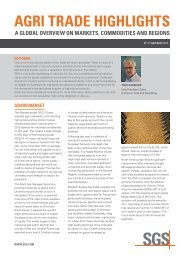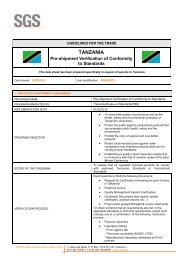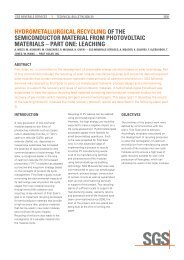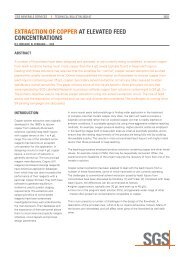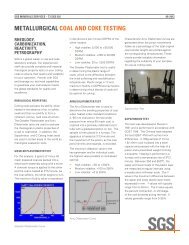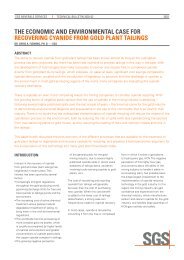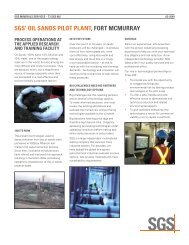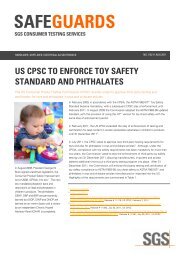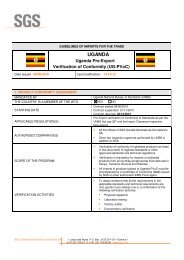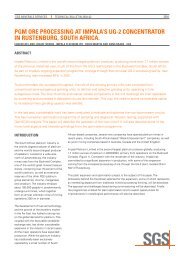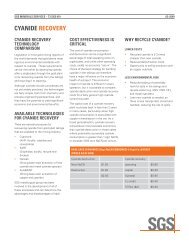Recovery at Northmet Deposit - SGS
Recovery at Northmet Deposit - SGS
Recovery at Northmet Deposit - SGS
You also want an ePaper? Increase the reach of your titles
YUMPU automatically turns print PDFs into web optimized ePapers that Google loves.
<strong>SGS</strong> MINERALS SERVICES TECHNICAL BULLETIN 2006-06 2006<br />
METALLURGICAL PROCESSING OF POLYMET MINING’S<br />
NORTHMET DEPOSIT FOR RECOVERY OF Cu-Ni-Co-Zn-Pd-Pt-<br />
Au<br />
DAVID DREISINGER, WILLIAM MURRAY AND DON HUNTER –– POLYMET MINING; KEN BAXTER, MIKE WARDELL-JOHNSON, ALAN<br />
LANGLEY AND JENNI LIDDICOAT –– BATEMAN ENGINEERING; CHRIS FLEMING, JOE FERRON, ALEX MEZEI, JAMES BROWN, RON<br />
MOLNAR AND DAN IMESON ––<strong>SGS</strong><br />
INTRODUCTION<br />
PolyMet Mining Corp. (PolyMet) is advancing the development of the NorthMet Project. The NorthMet deposit<br />
is loc<strong>at</strong>ed in northern Minnesota, adjacent to the historic Iron Range. The deposit was discovered in the 1960’s<br />
and consists of a large, lower grade polymetallic sulfide deposit with values in Cu, Ni, Co, Zn, Au and Pl<strong>at</strong>inum<br />
Group Metals (PGM). The NorthMet resource is estim<strong>at</strong>ed <strong>at</strong> > 900 million tons @ >0.90 Cu Equivalent grade <strong>at</strong> a<br />
0.15% Cu cut off grade.<br />
PolyMet is currently completing a<br />
Definitive Feasibility Study (DFS) with<br />
B<strong>at</strong>eman Engineering (Australia). The<br />
study will include the mining, mineral<br />
processing and hydrometallurgical<br />
tre<strong>at</strong>ment of a bulk concentr<strong>at</strong>e along<br />
with waste handling and disposal. The<br />
processing site will be the former LTV<br />
Steel Mining Company taconite iron<br />
ore processing plant which is loc<strong>at</strong>ed<br />
about 7 miles from the NorthMet<br />
deposit. The plant and associ<strong>at</strong>ed mining<br />
oper<strong>at</strong>ions were closed in early 2001<br />
due to bankruptcy and <strong>at</strong> its peak, this<br />
plant processed over 90,000 long tons/<br />
day of taconite iron ore via a four stage<br />
crushing, grinding and flot<strong>at</strong>ion process.<br />
PolyMet is now the owner of this plant<br />
(purchase was completed in 2005) and<br />
plans to reactiv<strong>at</strong>e sufficient capacity<br />
to tre<strong>at</strong> 32,000 short tons per day<br />
of NorthMet ore to produce a bulk<br />
sulfide flot<strong>at</strong>ion concentr<strong>at</strong>e for further<br />
tre<strong>at</strong>ment using the PLATSOL process.<br />
The DFS program has included pilot scale<br />
testwork <strong>at</strong> <strong>SGS</strong> Lakefield Research<br />
Limited in Ontario, Canada. Pilot plant<br />
tests have been performed on ore<br />
flot<strong>at</strong>ion to produce bulk concentr<strong>at</strong>e<br />
samples and on hydrometallurgical<br />
tre<strong>at</strong>ment of the bulk concentr<strong>at</strong>e<br />
m<strong>at</strong>erials. Two variants of the<br />
hydrometallurgical process were tested.<br />
The “base case” flowsheet involves high<br />
temper<strong>at</strong>ure chloride-assisted leaching<br />
(PLATSOL), solid-liquid separ<strong>at</strong>ion<br />
and washing, PGM/Au precipit<strong>at</strong>ion,<br />
neutraliz<strong>at</strong>ion, Cu SX/EW to produce<br />
copper c<strong>at</strong>hode. The two variants,<br />
driven by offtake interest, include two<br />
different routes to nickel, cobalt, and<br />
zinc recovery. The first vari<strong>at</strong>ion tre<strong>at</strong>s a<br />
portion of the Cu SX raffin<strong>at</strong>e (remainder<br />
is recycled to the autoclave) sequentially<br />
by neutraliz<strong>at</strong>ion, first and second stage<br />
iron/aluminum removal, residual copper<br />
removal by precipit<strong>at</strong>ion as a sulfide,<br />
first stage Ni/Co/Zn precipit<strong>at</strong>ion with<br />
magnesia, second stage Ni/Co/Zn<br />
precipit<strong>at</strong>ion with lime and then<br />
magnesium removal with lime. The<br />
product from this first vari<strong>at</strong>ion is a<br />
“mixed” hydroxide of nickel, cobalt and<br />
zinc.<br />
The second vari<strong>at</strong>ion again tre<strong>at</strong>s<br />
a portion of the Cu SX raffin<strong>at</strong>e<br />
sequentially by neutraliz<strong>at</strong>ion, first and<br />
second stage iron/aluminum removal<br />
and residual copper sulfide precipit<strong>at</strong>ion.<br />
The Cu-Fe-Al free solution is then<br />
processed by Co/Zn solvent extraction<br />
(with Cyanex 272) with selective zinc<br />
and cobalt stripping, cobalt precipit<strong>at</strong>ion<br />
with magnesia, nickel (purified raffin<strong>at</strong>e<br />
stream after Co/Zn SX) precipit<strong>at</strong>ion with<br />
magnesia, secondary precipit<strong>at</strong>ion of<br />
residual nickel with lime and finally<br />
magnesium precipit<strong>at</strong>ion with lime. The<br />
products from this second vari<strong>at</strong>ion are<br />
a zinc sulf<strong>at</strong>e strip solution (to a zinc offtake),<br />
a cobalt hydroxide precipit<strong>at</strong>e and<br />
a nickel hydroxide precipit<strong>at</strong>e.<br />
The final choice between the mixed and<br />
purified hydroxide route for nickel and<br />
cobalt products will be based on final<br />
cost analysis and market surveys.<br />
The following paper provides an<br />
overview of the current project and<br />
results from the pilot testing.<br />
NORTHMET PROJECT<br />
The NorthMet Project is loc<strong>at</strong>ed in<br />
northeastern Minnesota, near the<br />
Mesabi Iron Range and 6 miles<br />
south of the town of Babbitt. Figure 1<br />
shows the loc<strong>at</strong>ion on a map of North<br />
America.<br />
PolyMet has a 100% leasehold interest<br />
for the mineral rights on the 4,162 acres<br />
th<strong>at</strong> make up the NorthMet property. The<br />
infrastructure is excellent. Available to<br />
the Project are low-cost power, well<br />
developed roads and railway networks,<br />
and supply-equipment centers th<strong>at</strong><br />
support the numerous oper<strong>at</strong>ing iron ore
<strong>SGS</strong> MINERALS SERVICES TECHNICAL BULLETIN 2006-06<br />
mines, the nearest being two miles from<br />
NorthMet. There is an abundant supply<br />
of skilled labor locally.<br />
The NorthMet deposit is believed<br />
to be the largest undeveloped nonferrous<br />
metal project in the U.S. It is a<br />
polymetallic magm<strong>at</strong>ic sulfide deposit<br />
containing pl<strong>at</strong>inum, palladium, gold,<br />
copper, nickel, cobalt, and silver, hosted<br />
near the base of the Duluth Mafic<br />
Complex.<br />
Historically, the approach taken to<br />
development of NorthMet (formerly<br />
named the Dunka Road deposit), was<br />
to use open pit mining and flot<strong>at</strong>ion/<br />
concentr<strong>at</strong>ion of smelter grade nickel and<br />
copper concentr<strong>at</strong>es for toll tre<strong>at</strong>ment.<br />
With prevailing smelter payment terms<br />
(and associ<strong>at</strong>ed smelting and refining<br />
charges), the economics were never<br />
<strong>at</strong>tractive enough for NorthMet to<br />
proceed as a “greenfields” project<br />
development using this approach. The<br />
losses of nickel and copper to tails and<br />
to the other concentr<strong>at</strong>es and the<br />
rel<strong>at</strong>ively low levels of precious metals in<br />
the final concentr<strong>at</strong>es mitig<strong>at</strong>ed against<br />
financial success. Starting in 1998, a new<br />
approach was taken to development of<br />
NorthMet including bulk flot<strong>at</strong>ion of the<br />
copper, nickel and associ<strong>at</strong>ed base and<br />
precious metals and hydrometallurgical<br />
tre<strong>at</strong>ment of the bulk concentr<strong>at</strong>e.<br />
The NorthMet deposit is situ<strong>at</strong>ed<br />
approxim<strong>at</strong>ely 7 miles from the former<br />
LTV Steel Mining Company (LTV) taconite<br />
iron ore processing facility which prior to<br />
its closure due to bankruptcy in 2001 had<br />
capacity to tre<strong>at</strong> over 90,000 long<br />
tons per day of taconite. Following<br />
closure Cliffs Erie LLC (a subsidiary<br />
of Cleveland Cliffs Inc.) acquired the<br />
mining and railroad rel<strong>at</strong>ed assets.<br />
PolyMet management recognized the<br />
opportunity th<strong>at</strong> the disused taconite<br />
processing facility represented in terms<br />
of advancing NorthMet to production and<br />
in 2003 secured an option to purchase<br />
the crushing plant, concentr<strong>at</strong>or, tailings<br />
impoundment and selected associ<strong>at</strong>ed<br />
infrastructure. The option was<br />
exercised in l<strong>at</strong>e 2005.<br />
The significance of this acquisition<br />
is th<strong>at</strong> the former LTV facilities and<br />
infrastructure now provide<br />
Figure 1 The loc<strong>at</strong>ion of the NorthMet deposit, Minnesota, USA<br />
the ready made comminution “front end” of the two-stage NorthMet processing route<br />
with a corresponding capital cost saving of several hundreds of millions of dollars.<br />
Given th<strong>at</strong> the r<strong>at</strong>e of initial tre<strong>at</strong>ment of NorthMet ore is 32,000 short tons per day,<br />
there is considerable scope for future expansion.<br />
Figure 2 Overview of the “Cliff’s Erie” Site Purchased by PolyMet Mining Corp. (This photograph was<br />
taken when the plant was producing taconite pellets seen in the foreground stockpiled ready for<br />
rail shipment.)<br />
DRILL PROGRAM<br />
During 2005 a diamond drilling program was carried out which focused on the areas<br />
th<strong>at</strong> are expected to be mined in the first 20 years of the mine plan. The first phase<br />
of the program was intended to provide additional resource definition as well as a<br />
42 short ton bulk sample for metallurgical testing <strong>at</strong> <strong>SGS</strong> Lakefield Research near<br />
Toronto, Ontario. The resultant bulk sample, which represented the envelope expected<br />
2
<strong>SGS</strong> MINERALS SERVICES TECHNICAL BULLETIN 2006-06<br />
to be mined during the first 10 years of<br />
production, was composited as three<br />
separ<strong>at</strong>e blended samples representing<br />
the expected high, medium and low<br />
grade mill feed values. Subsequently, in<br />
early 2006, an additional 9 short tons of<br />
drill-derived m<strong>at</strong>erial in two composite<br />
samples were subjected to a further<br />
phase of pilot-scale flot<strong>at</strong>ion and<br />
autoclave testing <strong>at</strong> Lakefield.<br />
A final phase of DFS diamond drilling,<br />
which comprised exclusively of resource<br />
definition and in-fill drilling, was carried<br />
out during the winter of 2005-2006 and<br />
completed in February 2006.<br />
All of the goals for the drill program have<br />
been met, including:<br />
• G<strong>at</strong>hering geotechnical inform<strong>at</strong>ion for<br />
pit slope design -- pit slope stability<br />
studies by Golder Associ<strong>at</strong>es are<br />
nearing completion;<br />
• Enhancing the comprehensive<br />
geological model through in-fill drilling<br />
-- a new, detailed geological and assay<br />
model incorpor<strong>at</strong>ing all work from 2005<br />
has been completed and is contributing<br />
to ongoing resource evalu<strong>at</strong>ion and pit<br />
design work by PolyMet staff, resource<br />
consultants Hellman & Schofield and<br />
Australian Mine Development and<br />
Design (AMDAD);<br />
• Confirming continuity of metal grades;<br />
• Collecting d<strong>at</strong>a to support<br />
environmental permitting, and<br />
• Improvement in the confidence of<br />
resource estim<strong>at</strong>e c<strong>at</strong>egoriz<strong>at</strong>ion<br />
resulting from reduced drill hole and<br />
sample spacing.<br />
During the 2005 program, 109 holes<br />
totaling 77,166 feet were drilled taking<br />
the cumul<strong>at</strong>ive drilling <strong>at</strong> the project to<br />
310 diamond and reverse circul<strong>at</strong>ion<br />
holes totaling 261,227 feet. In addition<br />
to the l<strong>at</strong>est drill program, PolyMet<br />
has meticulously recompiled all of the<br />
prior work started by US Steel in 1969,<br />
increasing the number of samples<br />
from nearly 12,000 to 17,194. The l<strong>at</strong>est<br />
program added a further 12,806 samples,<br />
taking the total to 30,000.<br />
In addition, drill spacing in the area<br />
to be mined in the first five years has<br />
been reduced to an average of 311<br />
feet (from 427 feet) while the 20-year<br />
mine plan spacing has been reduced<br />
to an average of 360 feet. In Hellman<br />
& Schofield’s 2005 report, a spacing of<br />
360 feet was used to define m<strong>at</strong>erial<br />
in the “Measured” c<strong>at</strong>egory. Hellman<br />
& Schofield is currently finalizing the<br />
DFS Resource Estim<strong>at</strong>e which includes<br />
results from all drilling done on the<br />
NorthMet deposit to d<strong>at</strong>e.<br />
NORTHMET PROCESS<br />
FLOWSHEET AND PILOT PLANT<br />
STUDIES<br />
The overall NorthMet process flowsheet<br />
involves two distinct circuits; a classical<br />
mineral processing flowsheet to produce<br />
a bulk concentr<strong>at</strong>e and a hydrometallurgy<br />
flowsheet for extracting Cu-Ni-Co-Zn-<br />
Au-PGM from the bulk concentr<strong>at</strong>e.<br />
The hydrometallurgy flowsheet involves<br />
chloride-assisted leaching of base<br />
and precious metals followed by a<br />
series of metal recovery steps for the<br />
base and precious metals. Within the<br />
hydrometallurgy process flowsheet,<br />
there are two options for nickel and<br />
cobalt recovery th<strong>at</strong> have been carried<br />
in parallel through testwork and<br />
engineering. Final selection between<br />
Table 1. Pilot Plant Ore Samples Processed <strong>at</strong> <strong>SGS</strong> in 2005 and 2006<br />
SAMPLE* WEIGHT (t) ASSAY (% or g/t)<br />
Cu Ni S Pt Pd Au<br />
Composite 1 9.5 0.31 0.095 0.73 0.06 0.23 0.03<br />
Composite 2 19.2 0.35 0.1 0.77 0.07 0.33 0.05<br />
Composite 3 9.6 0.4 0.11 0.87 0.09 0.3 0.05<br />
Startup<br />
M<strong>at</strong>erial<br />
3.6 0.31 0.09 0.87 0.04 0.31 0.05<br />
Composite 4 4.4 0.31 0.1 0.91 0.05 0.28 0.08<br />
* Composites 1-3 were processed in 2005 and the Startup M<strong>at</strong>erial and Composite 4 were processed in<br />
2006<br />
the two options will be determined by<br />
analysis of rel<strong>at</strong>ive capital and oper<strong>at</strong>ing<br />
costs and final discussions with metal<br />
off-take parties. The first option produces<br />
a “mixed hydroxide” which will also<br />
contain any zinc th<strong>at</strong> reports to the bulk<br />
flot<strong>at</strong>ion concentr<strong>at</strong>e. The second option<br />
utilizes solvent extraction to separ<strong>at</strong>e<br />
Ni, Co and Zn into separ<strong>at</strong>e streams<br />
for precipit<strong>at</strong>ion as individual metal<br />
hydroxides.<br />
Figures 3, 4, 5 show the flowsheets in<br />
pictorial form. Figure 3 is the mineral<br />
processing flowsheet with figures 4<br />
and 5 showing the two options for<br />
hydrometallurgy.<br />
3<br />
The pilot scale tests <strong>at</strong> <strong>SGS</strong>-Lakefield<br />
were performed in 2005 and 2006.<br />
The ore samples sent to <strong>SGS</strong>-Lakefield<br />
comprised 4 composites and a sample<br />
of assay reject m<strong>at</strong>erial th<strong>at</strong> was used as<br />
“startup” m<strong>at</strong>erial for the flot<strong>at</strong>ion pilot<br />
plant. The ore samples were processed<br />
through crushing, grinding and flot<strong>at</strong>ion<br />
to produce a series of bulk concentr<strong>at</strong>es<br />
for hydrometallurgical pilot plant testing.<br />
Table 1 below summarizes the pilot plant<br />
feed assays and weights processed.<br />
The following is a general description of<br />
each part of the proposed plant along<br />
with selected results from the 2005<br />
and 2006 continuous pilot testing of the<br />
process <strong>at</strong> <strong>SGS</strong> Lakefield. The pilot scale<br />
tests <strong>at</strong> <strong>SGS</strong> Lakefield form the testwork<br />
basis for the final feasibility study design<br />
for the NorthMet plant.<br />
CRUSHING, GRINDING AND FLOTATION<br />
The crushing, grinding and flot<strong>at</strong>ion<br />
circuit (Figure 3) receives ore from the<br />
mine into a coarse crusher dump pocket.<br />
The ore then proceeds through primary,<br />
secondary, tertiary and qu<strong>at</strong>ernary<br />
crushing followed by rod and ball milling<br />
to a size of 100-125 μm P 80 . The crushing<br />
and grinding circuits are existing circuits<br />
within the “Cliff’s Erie” plant and will only<br />
utilize a small portion of the available<br />
capacity.
<strong>SGS</strong> MINERALS SERVICES TECHNICAL BULLETIN 2006-06<br />
The flot<strong>at</strong>ion circuit is designed to<br />
produce a bulk concentr<strong>at</strong>e carrying pay<br />
metals and a tailing with low residual<br />
sulfur content. The flo<strong>at</strong> circuit has the<br />
following elements;<br />
• Rougher conditioning with potassium<br />
amyl xanth<strong>at</strong>e (PAX)<br />
• Rougher flot<strong>at</strong>ion with MIBC/DF250<br />
addition<br />
• Scavenger flot<strong>at</strong>ion conditioning with<br />
copper sulf<strong>at</strong>e (to activ<strong>at</strong>e sulfides)<br />
• Scavenger flot<strong>at</strong>ion with applic<strong>at</strong>ion of<br />
PAX, MIBC and DF250.<br />
• The rougher flo<strong>at</strong> concentr<strong>at</strong>e (and<br />
the first scavenger flo<strong>at</strong> concentr<strong>at</strong>e<br />
– not shown on Figure 4) is sent<br />
to conditioning followed by three<br />
stages of cleaning to produce a final<br />
concentr<strong>at</strong>e.<br />
• The scavenger flot<strong>at</strong>ion concentr<strong>at</strong>e<br />
and the first cleaner flot<strong>at</strong>ion tailings<br />
are reground to 30 μm particle size<br />
(P 80 ) and directed back to the rougher<br />
flot<strong>at</strong>ion circuit<br />
• The 3rd cleaner concentr<strong>at</strong>e<br />
is thickened and reground to<br />
approxim<strong>at</strong>ely 15 μm particle size (P 80 )<br />
and sent to the autoclave feed tanks.<br />
A series of b<strong>at</strong>ch and continuous pilot<br />
plant crushing/grinding/flot<strong>at</strong>ion tests<br />
were performed <strong>at</strong> <strong>SGS</strong>Lakefield as<br />
part of the metallurgical development<br />
program. The results of a series of six<br />
Figure 3 NorthMet Process Flowsheet: Crushing, Grinding and Flot<strong>at</strong>ion of a Bulk Cu-Ni-Co-Zn-Au-PGM Concentr<strong>at</strong>e<br />
test periods are summarized in Table<br />
2. The first two sample periods were<br />
tre<strong>at</strong>ing assay reject “startup” m<strong>at</strong>erial<br />
followed by tre<strong>at</strong>ment of a composite<br />
(C4). The C4 composite sample was<br />
obtained from NorthMet deposit in the<br />
area of the first 5 years of the NorthMet<br />
mine life. On average for the 4 periods<br />
in which C4 sample was processed, the<br />
results indic<strong>at</strong>e;<br />
• 3.73 % mass pull and flo<strong>at</strong> recoveries<br />
of 89.8% for Cu, 70.5% for Ni, 87.2%<br />
for S, 36.2% for Co, 73.3% for Au,<br />
84.7% for Pt and 82.7% for Pd.<br />
4
<strong>SGS</strong> MINERALS SERVICES TECHNICAL BULLETIN 2006-06<br />
Figure 4 NorthMet Process Flowsheet: Hydrometallurgical Tre<strong>at</strong>ment of Bulk Cu-Ni-Co-Zn-Au-PGM Concentr<strong>at</strong>e with Production of Copper C<strong>at</strong>hode, Au/PGM<br />
Precipit<strong>at</strong>e and Mixed Ni/Co Hydroxide.<br />
5
<strong>SGS</strong> MINERALS SERVICES TECHNICAL BULLETIN 2006-06<br />
Figure 5 NorthMet Process Flowsheet: Hydrometallurgical Tre<strong>at</strong>ment of Bulk Cu-Ni-Co-Zn-Au-PGM Concentr<strong>at</strong>e with Production of Copper C<strong>at</strong>hode, Au/PGM<br />
Precipit<strong>at</strong>e, Zinc Hydroxide, Nickel Hydroxide and Cobalt Hydroxide.<br />
Table 2 Selected Flot<strong>at</strong>ion Pilot Plant Test Results Obtained <strong>at</strong> <strong>SGS</strong> Lakefield in 2006<br />
Test<br />
No.<br />
Comp Product Wt<br />
%<br />
Grade Distribution, %<br />
Cu, % Ni, % S, % Co, % Au,<br />
g/t<br />
Pt, g/t Pd,<br />
g/t<br />
Cu Ni S Co Au Pt Pd<br />
1 Startup Feed 100 0.35 0.1 0.79 0.01 0.05 0.05 0.26 100 100 100 100 100 100 100<br />
Tail 96.8 0.036 0.035 0.13 0.007 0.008 0.006 0.044 9.9 32.4 16.2 66 16 11.2 16.7<br />
Conc 3.17 10.1 2.2 20.8 0.11 1.28 1.46 6.71 90.1 67.6 83.8 34 84 88.8 83.3<br />
2 Startup Feed 100 0.38 0.11 0.85 0.008 0.05 0.05 0.25 100 100 100 100 100 100 100<br />
Tail 96.2 0.032 0.03 0.12 0.005 0.009 0.009 0.043 8.1 27 14.1 57.2 16.3 16.3 3.4<br />
Conc 3.8 9.22 2.04 19.3 0.095 1.17 1.17 6.47 91.9 73 85.9 42.8 83.7 83.7 85.6<br />
3 C4 Feed 100 0.34 0.1 0.87 0.008 0.04 0.06 0.29 100 100 100 100 100 100 100<br />
Tail 96.4 0.034 0.03 0.12 0.005 0.014 0.008 0.053 9.6 28.7 13.6 58.6 31.2 13.3 17.7<br />
Conc 3.58 8.57 1.97 21.1 0.095 0.83 1.41 6.63 90.4 71.3 86.4 41.4 68.8 86.7 82.3<br />
4 C4 Feed 100 0.34 0.01 0.93 0.008 0.04 0.07 0.29 100 100 100 100 100 100 100<br />
Tail 95.8 0.037 0.029 0.11 0.005 0.006 0.005 0.051 10.5 28.7 11 62.7 13.6 6.7 16.8<br />
Conc 4.2 7.16 1.66 19.8 0.068 0.87 1.59 5.76 89.5 71.3 89 37.3 86.4 93.3 83.2<br />
5 C4 Feed 100 0.33 0.1 0.85 0.009 0.04 0.06 0.28 100 100 100 100 100 100 100<br />
Tail 96.3 0.032 0.028 0.1 0.006 0.01 0.008 0.044 9.3 27.3 11.5 63.7 25.8 13.7 15.3<br />
Conc 3.74 8.05 1.91 20 0.088 0.74 1.3 6.25 90.7 72.7 88.5 36.3 74.2 86.3 84.7<br />
6 C4 Feed 100 0.32 0.1 0.86 0.01 0.03 0.06 0.26 100 100 100 100 100 100 100<br />
Tail 96.6 0.039 0.034 0.13 0.007 0.013 0.018 0.052 11.6 33.1 15.1 70.2 36.2 27.6 19.4<br />
Conc 3.41 8.4 1.97 21.5 0.084 0.65 1.34 6.12 88.4 66.9 84.9 29.8 63.8 72.4 80.6<br />
6
<strong>SGS</strong> MINERALS SERVICES TECHNICAL BULLETIN 2006-06<br />
AUTOCLAVE LEACHING<br />
The autoclave leaching process for<br />
NorthMet utilizes a small amount<br />
of chloride (approxim<strong>at</strong>ely 10 g/L) in<br />
solution under “total pressure oxid<strong>at</strong>ion”<br />
conditions to extract Cu, Ni, Co, Zn, Au,<br />
Pt, Pd from the bulk concentr<strong>at</strong>e. The<br />
principles of the PLATSOL® process<br />
for NorthMet ore processing have been<br />
described elsewhere [1] and will only<br />
be briefly reviewed here. The process is<br />
regarded as a nominal “step-out” from<br />
commercial practice in total pressure<br />
oxid<strong>at</strong>ion for base and precious metal<br />
ore/concentr<strong>at</strong>e tre<strong>at</strong>ment.<br />
The autoclave oxid<strong>at</strong>ion process converts<br />
metal sulfide minerals into metal<br />
sulf<strong>at</strong>es and iron hydrolysis products<br />
(primarily hem<strong>at</strong>ite but some basic ferric<br />
sulf<strong>at</strong>e may also form under high acid<br />
conditions), while the precious metals<br />
are converted to chloro-complexes. The<br />
chemical reactions believed to occur in<br />
the autoclave are shown below. (Note<br />
th<strong>at</strong> the mineralogy of the PGM’s may be<br />
very complex, but for simplicity only the<br />
metallic species are considered.)<br />
Chalcopyrite Oxid<strong>at</strong>ion/Iron Hydrolysis:<br />
CuFeS 2 + 4.25O 2 + H 2 O = CuSO 4 +<br />
0.5Fe 2 O 3 + H 2 SO 4<br />
Pyrite Oxid<strong>at</strong>ion:<br />
FeS 2 + 3.75O 2 + 2H 2 O = 0.5Fe 2 O 3 +<br />
2H 2 SO 4<br />
Pyrrhotite Oxid<strong>at</strong>ion<br />
Fe7S 8 + 16.25O 2 + 8H 2 O = 3.5Fe 2 O 3 +<br />
8H 2 SO 4<br />
Nickel Sulfide Oxid<strong>at</strong>ion:<br />
NiS + 2O 2 = NiSO 4<br />
Basic Ferric Sulf<strong>at</strong>e Form<strong>at</strong>ion:<br />
Fe 2 O 3 + 2H 2 SO 4 = 2Fe(OH)SO 4 + H 2 O<br />
Gold Oxid<strong>at</strong>ion/Chlorocomplex<br />
Form<strong>at</strong>ion:<br />
Au + 0.75O 2 + 4HCl = HAuCl 4 + 1.5H 2 O<br />
Pl<strong>at</strong>inum Oxid<strong>at</strong>ion/Chlorocomplex<br />
Form<strong>at</strong>ion:<br />
Pt + O 2 + 6HCl = H 2 PtCl 6 + 2H 2 O<br />
Palladium Oxid<strong>at</strong>ion/Chlorocomplex<br />
Form<strong>at</strong>ion:<br />
Pd + 0.5O 2 + 4HCl = H 2 PdCl 4 + H 2 O<br />
The temper<strong>at</strong>ure range for total pressure<br />
oxid<strong>at</strong>ion is typically 220 to 230°C. The<br />
autoclave discharge from the leach<br />
process contains dissolved Cu, Ni,<br />
Co, Zn, Au, Pt and Pd. The solids are<br />
rel<strong>at</strong>ively “barren” of value, consisting<br />
of iron precipit<strong>at</strong>es, unreacted gangue<br />
and minor amounts of residual base and<br />
precious metal minerals.<br />
The original PLATSOL® pilot plant<br />
utilized a “straight through” design<br />
[1] in which fresh concentr<strong>at</strong>e was<br />
introduced into the first compartment<br />
of a 6-compartment pilot autoclave<br />
with raffin<strong>at</strong>e (for controlled cooling of<br />
the autoclave slurry) and oxygen (for<br />
oxid<strong>at</strong>ion). The results of the “straight<br />
through” pilot plant indic<strong>at</strong>ed th<strong>at</strong><br />
virtually all the copper and nickel were<br />
extracted in the first compartment of<br />
the autoclave due to the rapidity of the<br />
sulfide oxid<strong>at</strong>ion process. However,<br />
the pl<strong>at</strong>inum and palladium minerals<br />
continued to react through the entire<br />
autoclave volume, reaching ultim<strong>at</strong>e<br />
extractions of about 95%. This situ<strong>at</strong>ion<br />
was revisited in the more recent bench<br />
and pilot scale testing. It was concluded<br />
th<strong>at</strong> a “recycle’ design would be more<br />
efficient with respect to autoclave<br />
design. The “recycle” design involves<br />
thickening the autoclave discharge and<br />
recycling a portion of the underflow to<br />
the autoclave feed. This recycle allows<br />
for any unreacted mineral to have a<br />
chance <strong>at</strong> second-pass extraction. The<br />
gre<strong>at</strong>er the recycle, the longer the<br />
“average” residence time of solids in the<br />
autoclave. The limit of the recycle will be<br />
when the solids density in the autoclave<br />
becomes unmanageable.<br />
Figure 6 Copper and Nickel Extraction as a Function of Recycle of Autoclave Discharge Solids.<br />
Standard conditions: 225°C, 1.1 hour single pass residence time, 100 psig of oxygen overpressure,<br />
10 g/L Cl, 6-compartment autoclave.<br />
7<br />
Figures 6 and 7 shows the impact of<br />
solids recycle on base and precious<br />
metal extraction. While there is some<br />
“noise” in the results, there is a strong<br />
indic<strong>at</strong>ion of improvement in both base<br />
and precious metal extraction in applying<br />
the recycle system. Nickel extraction<br />
improved from 97% extraction to over<br />
98% while pl<strong>at</strong>inum and palladium<br />
extraction improved from less than 90%<br />
to between 90 and 95 overall extraction.<br />
Regardless of the recycle r<strong>at</strong>io, the<br />
copper extraction was excellent <strong>at</strong> over<br />
99%. Gold extraction was highly variable,<br />
probably due to the small amount of<br />
gold in the feed sample (0.8 to 1.3 g/t),<br />
but always around 90%. The method<br />
of reporting recycle is mass of recycle<br />
solids per mass of feed solids (t/t),<br />
expressed as a percent.
<strong>SGS</strong> MINERALS SERVICES TECHNICAL BULLETIN 2006-06<br />
Inspection of the graphs indic<strong>at</strong>es th<strong>at</strong><br />
<strong>at</strong> least 100% recycle r<strong>at</strong>io will improve<br />
overall metal extractions.<br />
Further insight into the kinetics of<br />
the pressure oxid<strong>at</strong>ion process can<br />
be obtained by taking compartment<br />
samples from the autoclave <strong>at</strong> steadyst<strong>at</strong>e.<br />
Figure 8 shows the precious metal<br />
solution and solids assays in the<br />
compartment samples obtained <strong>at</strong><br />
74% recycle r<strong>at</strong>io. Figure 9 gives the<br />
comparable inform<strong>at</strong>ion for the base<br />
metals. Note th<strong>at</strong> the feed grades in<br />
each case have been diluted with the<br />
barren solids recycled from the autoclave<br />
discharge.<br />
The results show clearly th<strong>at</strong> even with<br />
recycle and a rel<strong>at</strong>ively short autoclave<br />
residence time of 1.1 hours, the oxid<strong>at</strong>ion<br />
and extraction of the bulk of the base<br />
and precious metals is largely complete<br />
within the first two compartments of<br />
the autoclave (approxim<strong>at</strong>ely 22 minutes<br />
of the 66 minute residence time).<br />
This result is consistent with all other<br />
reported inform<strong>at</strong>ion on total pressure<br />
oxid<strong>at</strong>ion of sulfide concentr<strong>at</strong>es<br />
including the developments of Placer<br />
Dome and Phelps Dodge on copper<br />
concentr<strong>at</strong>e total oxid<strong>at</strong>ion [2, 3].<br />
The full plant design <strong>at</strong> NorthMet will<br />
allow for up to 300% recycle capacity to<br />
maximize extraction. Significantly, the<br />
use of recycle has allowed the specific<br />
throughput of the installed autoclaves<br />
to approxim<strong>at</strong>ely double with respect to<br />
fresh feed (tonnes of fresh feed per m 3<br />
of autoclave volume). There may well<br />
be scope, once the plant has started, to<br />
make further increases in intensific<strong>at</strong>ion<br />
of the process.<br />
AU AND PGM PRECIPITATION<br />
The autoclave discharge slurry is partly<br />
recycled (after thickening) and partly<br />
filtered to advance the metal bearing<br />
solution to the downstream recovery<br />
steps in the process. The gold and<br />
pl<strong>at</strong>inum group metals in solution are the<br />
first target for recovery using reductive<br />
precipit<strong>at</strong>ion.<br />
In the first PLATSOL® pilot plant<br />
reported in 2001 [1], a combin<strong>at</strong>ion of<br />
sulfur dioxide reduction of ferric ion<br />
followed by sulfide precipit<strong>at</strong>ion was<br />
Figure 7 Au, Pt and Pd Extraction as a Function of Recycle of Autoclave Discharge Solids.<br />
Standard conditions: 225°C, 1.1 hour single pass residence time, 100 psig of oxygen overpressure,<br />
10 g/L Cl, 6-compartment autoclave.<br />
used to recover the precious metals<br />
from the pregnant solution.<br />
In the recent pilot campaign an improved<br />
method of precious metal recovery was<br />
tested. Copper sulfides produced by<br />
precipit<strong>at</strong>ion of copper from the bleed<br />
stream advancing to nickel and cobalt<br />
recovery were utilized for precious metal<br />
recovery. The copper sulfides “cement”<br />
the precious metals onto the solid<br />
surface, resulting in an enriched product<br />
to advance to further processing.<br />
The improved process was proven<br />
to be robust and flexible. It is still<br />
advantageous to reduce the ferric<br />
species in the advancing solution using<br />
sulfur dioxide gas to minimize the CuS<br />
demand for Au and PGM precipit<strong>at</strong>ion.<br />
Ferric Reduction<br />
Fe 2 (SO 4 ) 3 + SO 2 + 2H 2 O = 2FeSO 4 +<br />
2H 2 SO 4<br />
Gold Precipit<strong>at</strong>ion<br />
2HAuCl 4 + 3CuS + 3H 2 SO 4 = 2Au +<br />
3CuSO 4 + 8HCl + 3S<br />
Pl<strong>at</strong>inum Precipit<strong>at</strong>ion<br />
H 2 PtCl 6 + 2CuS + 2H 2 SO 4 = Pt + 2CuSO 4<br />
+ 6HCl + 2S<br />
Palladium Precipit<strong>at</strong>ion<br />
H 2 PdCl 4 + CuS + H 2 SO 4 = Pd + CuSO 4 +<br />
4HCl + S<br />
The recovery of gold, pl<strong>at</strong>inum and<br />
palladium from the autoclave solution<br />
(after filtering and washing the solids)<br />
was accomplished by precipit<strong>at</strong>ion with<br />
CuS in the pilot plant. The precipit<strong>at</strong>e<br />
solids are collected in a thickener/<br />
clarifier arrangement and then<br />
filtered. Recoveries of gold, pl<strong>at</strong>inum<br />
and palladium into this precipit<strong>at</strong>e<br />
concentr<strong>at</strong>e were excellent, in excess of<br />
99.5% in each case. Base metal losses<br />
from solution into the PGM and gold<br />
residue were negligible.<br />
Approxim<strong>at</strong>ely 4 kg of precipit<strong>at</strong>e were<br />
collected during the 2005 pilot plant<br />
analyzing 56 g/t Au, 211 g/t Pt and 907<br />
g/t Pd. Most of the precipit<strong>at</strong>e mass<br />
was copper (35.7%) and sulfur (49%).<br />
B<strong>at</strong>ch releaching of the precipit<strong>at</strong>e to<br />
remove copper and sulfur was tested<br />
and resulted in an upgraded m<strong>at</strong>erial<br />
analyzing approxim<strong>at</strong>ely 1.6% or 16,000<br />
g/t total contained gold, pl<strong>at</strong>inum and<br />
palladium. PolyMet will chose between<br />
placement of the primary precipit<strong>at</strong>e or<br />
the re-leach residue with an offtake/<br />
refinery partner for final separ<strong>at</strong>ion into<br />
pure precious metal products.<br />
The solution after gold, pl<strong>at</strong>inum and<br />
palladium recovery advances to base<br />
metal recovery. The solution is still acidic<br />
and must be neutralized prior to copper<br />
solvent extraction.<br />
SOLUTION NEUTRALIZATION<br />
The extraction of copper by solvent<br />
extraction is inhibited by acid in solution.<br />
It is therefore important to neutralize the<br />
excess acid from the autoclave process<br />
prior to advancing to copper recovery.<br />
8
<strong>SGS</strong> MINERALS SERVICES TECHNICAL BULLETIN 2006-06<br />
Figure 8 Compartment Sample Assays for 74% Recycle R<strong>at</strong>io for Au, Pt, Pd <strong>at</strong> Steady St<strong>at</strong>e. (a) Solution Assays and (b) Solid Assays.<br />
9
<strong>SGS</strong> MINERALS SERVICES TECHNICAL BULLETIN 2006-06<br />
Figure 9 Compartment Sample Assays for 74% Recycle R<strong>at</strong>io for Ni, Cu, Fe <strong>at</strong> Steady St<strong>at</strong>e. (a) Solution<br />
Assays and (b) Solid Assays.<br />
Table 3 Gypsum Solids Assay from Neutraliz<strong>at</strong>ion of Autoclave Acid<br />
10<br />
The neutraliz<strong>at</strong>ion process was piloted in<br />
a three stage neutraliz<strong>at</strong>ion circuit with<br />
limestone slurry for neutraliz<strong>at</strong>ion. The<br />
gypsum product is thickened. A 300%<br />
recycle of gypsum as “seed” for<br />
precipit<strong>at</strong>ion was used to grow coarse,<br />
clean, crystals of gypsum.<br />
The chemistry of neutraliz<strong>at</strong>ion is shown<br />
below.<br />
Gypsum Precipit<strong>at</strong>ion<br />
H 2 SO 4 + CaCO 3 + 2H 2 O = CaSO 4.2 H 2 O<br />
The utiliz<strong>at</strong>ion of carbon<strong>at</strong>e exceeded<br />
99% in the pilot tests due to the use of<br />
the 300% recycle. The gypsum product<br />
assay is shown below. The chemical<br />
quality, physical n<strong>at</strong>ure and colour of this<br />
synthetic gypsum produced in the pilot<br />
plant appear to be suitable for entry into<br />
the gypsum wallboard market in the U.S.<br />
If an “off-take” for synthetic gypsum<br />
can be finalized, the gypsum residue<br />
will not fill space in the lined tailings<br />
facility planned for “hydromet” tailings.<br />
The value of the gypsum will partially<br />
offset the cost of oxygen for oxid<strong>at</strong>ion<br />
of sulfur in the concentr<strong>at</strong>e to sulf<strong>at</strong>e<br />
and the cost of purchasing limestone for<br />
neutraliz<strong>at</strong>ion.<br />
COPPER SX/EW<br />
The recovery of copper by SX/EW is<br />
conventional technology. The presence<br />
of chloride in the feed solution to copper<br />
solvent extraction necessit<strong>at</strong>es the<br />
applic<strong>at</strong>ion of a wash or scrub step to<br />
displace any entrained chloride from the<br />
loaded organic solution.<br />
Ni % Co % Cu % Fe % Zn % SiO 2 % Al 2 O 3 %<br />
0.05
<strong>SGS</strong> MINERALS SERVICES TECHNICAL BULLETIN 2006-06<br />
Copper Extraction<br />
CuSO 4 + 2HR(org) = CuR 2 (org) + H 2 SO 4<br />
Copper Stripping<br />
CuR 2 (org) + H 2 SO 4 = CuSO 4 + 2HR(org)<br />
Copper Electrowinning<br />
CuSO 4 + H 2 O = Cu + O 2 (gas) + H 2 SO 4<br />
In the pilot plant, copper was extracted<br />
in three counter-current stages,<br />
scrubbed in one and stripped in two<br />
stages with spent electrolyte from the<br />
electrowinning cell. Two extractants<br />
were evalu<strong>at</strong>ed, 35% Acorga M5640<br />
from Cytec in Orfom SX 80CT and 35%<br />
LIX 973NS LV from Cognis in the same<br />
diluent. Both extractants performed well<br />
in the pilot plant oper<strong>at</strong>ion. Extractions<br />
averaged about 95 % from a starting<br />
solution concentr<strong>at</strong>ion of 17.4 g/L of Cu<br />
(average). A total of 68 kg of copper were<br />
extracted and electrolyzed during the<br />
2005 pilot plant run <strong>at</strong> a current density<br />
of +270 A/m 2 . The copper metal c<strong>at</strong>hode<br />
was analyzed and found to meet LME<br />
grade A copper purity specific<strong>at</strong>ions. This<br />
product can be sold directly to copper<br />
consumers. Table 4 summarizes the<br />
assay for copper for two samples taken<br />
from the second strip cycle in the pilot<br />
plant.<br />
RAFFINATE NEUTRALIZATION<br />
The purpose of raffin<strong>at</strong>e neutraliz<strong>at</strong>ion<br />
is to trim the acid level in the copper<br />
raffin<strong>at</strong>e prior to splitting the raffin<strong>at</strong>e<br />
flow between the nickel and cobalt<br />
recovery circuit and returning the<br />
raffin<strong>at</strong>e to the autoclave circuit as<br />
a cooling solution. Acid must be<br />
neutralized prior to the nickel and cobalt<br />
recovery process steps and excess<br />
acid is undesirable in the feed to the<br />
autoclave as excess acid will increase<br />
the form<strong>at</strong>ion of basic ferric sulf<strong>at</strong>e in the<br />
autoclave solids.<br />
The chemistry of raffin<strong>at</strong>e neutraliz<strong>at</strong>ion<br />
is the same as the primary neutraliz<strong>at</strong>ion<br />
discussed above.<br />
Fe AND Al REMOVAL<br />
The removal of iron and aluminum<br />
prior to recovery of nickel and cobalt<br />
is necessary to prevent product<br />
contamin<strong>at</strong>ion.<br />
The process of iron oxy-hydrolysis is well<br />
known. Iron is oxidized from the ferrous<br />
Table 4. Copper Assays for Samples Taken from the Second Pilot Plant Strip Cycle 1 .<br />
Analysis (g/t)<br />
Sample Fe S Pb Ag<br />
C<strong>at</strong>hode 1 1.02 10.5 0.52
<strong>SGS</strong> MINERALS SERVICES TECHNICAL BULLETIN 2006-06<br />
Table 5. Analysis of the Mixed Hydroxide Product from the Pilot Plant<br />
Sample Moist. % Ni % Co % Cu % Fe % Zn % Al % Mg % Ca % Si % Mn %<br />
1 51.2 36.3 1.92 0.37 0.59 4.84 0.07 1.04 0.02 0.05 0.03<br />
2 41.2 31.5 1.67 0.31 0.51 4.31 0.04 0.62 0.04 0.03 0.02<br />
Residual Nickel Precipit<strong>at</strong>ion with Lime<br />
NiSO 4 + CaO + 3H 2 O = Ni(OH) 2 + CaSO 4.2 H 2 O<br />
Residual Cobalt Precipit<strong>at</strong>ion with Lime<br />
CoSO 4 + CaO + 3H 2 O = Co(OH) 2 + CaSO 4.2 H 2 O<br />
Residual Nickel Precipit<strong>at</strong>ion with Lime<br />
ZnSO 4 + CaO + 3H 2 O = Zn(OH) 2 + CaSO 4.2 H 2 O<br />
31.3 1.67 0.32 0.54 4.27 0.04 0.62 0.04 0.03 0.02<br />
3 56.3 40.6 2.17 0.41 0.68 0.56 0.05 0.76
<strong>SGS</strong> Technical Paper #2006-06<br />
<strong>SGS</strong> MINERALS SERVICES TECHNICAL BULLETIN 2006-06<br />
ENVIRONMENTAL TESTING AND<br />
SPECIALIST CONSULTANT TESTING<br />
Barr Engineering of Minnesota,<br />
PolyMet’s principal environmental<br />
review and permitting firm, was present<br />
throughout the pilot plant oper<strong>at</strong>ion to<br />
collect environmental d<strong>at</strong>a for emission<br />
and waste characteriz<strong>at</strong>ion purposes.<br />
The pilot plant oper<strong>at</strong>ion is essentially<br />
a scaled down version of the full scale<br />
plant under design and therefore<br />
represents an ideal opportunity to obtain<br />
key environmental d<strong>at</strong>a. Environmental<br />
d<strong>at</strong>a collected during piloting are being<br />
used by an independent contractor to<br />
prepare the mand<strong>at</strong>ed Environmental<br />
Impact St<strong>at</strong>ement and to define<br />
methods of mitig<strong>at</strong>ion and environmental<br />
management.<br />
Specialist consultants from reagent<br />
suppliers and solid-liquid separ<strong>at</strong>ion<br />
vendors were also present to test<br />
applicability of reagents and measure<br />
properties of slurries for final design<br />
specific<strong>at</strong>ion.<br />
CONCLUSIONS<br />
The NorthMet project of PolyMet<br />
Mining is well advanced in the Definitive<br />
Feasibility Study stage of project<br />
execution. The final feasibility document<br />
from B<strong>at</strong>eman Engineering is due in<br />
mid-2006.<br />
CONTACT INFORMATION<br />
Email us <strong>at</strong> minerals@sgs.com<br />
WWW.<strong>SGS</strong>.COM/MINERALS<br />
The metallurgical approach to<br />
development of the NorthMet deposit<br />
is to flo<strong>at</strong> a bulk concentr<strong>at</strong>e carrying<br />
the Cu-Ni-Co-Au-Pt-Pd values and<br />
then use the PLATSOL process<br />
for the tre<strong>at</strong>ment of the concentr<strong>at</strong>e.<br />
The PLATSOL process will dissolve<br />
all the metals of value to high levels<br />
of extraction in the main autoclave,<br />
followed by a series of precipit<strong>at</strong>ion and<br />
SX/EW processes for recovery of final<br />
metal products.<br />
The final products from the pilot plant<br />
will include;<br />
• Copper C<strong>at</strong>hode of LME Grade A<br />
Quality;<br />
• Au and PGM Precipit<strong>at</strong>e for Toll<br />
Processing;<br />
• Mixed Hydroxide Product Containing<br />
Ni-Co-Zn, or;<br />
• Separ<strong>at</strong>e Purified Nickel and Cobalt<br />
Hydroxide Products and either a Zinc<br />
Hydroxide or a Zinc Strip Solution<br />
• Synthetic Gypsum<br />
The current design basis is for an initial 32,000 short tons of ore per day to be<br />
processed through the refurbished Cliff’s Erie plant and a new hydrometallurgical<br />
refinery for metal extraction.<br />
REFERENCES<br />
Ferron, C. J.; Fleming, C. A.; O’Kane, P. T.; Dreisinger, D., “Pilot plant demonstr<strong>at</strong>ion of<br />
the PLATSOL process for the tre<strong>at</strong>ment of the NorthMet copper-nickel PGM deposit”,<br />
Mining Engineering (Littleton, CO, United St<strong>at</strong>es) (2002), 54(12), 33-39.<br />
Marsden, J.O., Brewer, R.E., Hazen, N., “Copper Concentr<strong>at</strong>e Leaching Developments<br />
by Phelps Dodge Corpor<strong>at</strong>ion”, Hydrometallurgy 2003, Eds. C.A. Young, A.M. Alfantazi,<br />
C.G. Anderson, D.B. Dreisinger, B. Harris and A. James, TMS (Warrendale, USA), 2003,<br />
1429-1446.<br />
Brewer, R.E., “Copper Concentr<strong>at</strong>e Pressure Leaching – Plant Scale-Up from<br />
Continuous Labor<strong>at</strong>ory Testing”, Minerals and Metallurgical Processing, November,<br />
2004, 21(4), 202-208.<br />
13<br />
© 2011 <strong>SGS</strong>. All rights reserved. The inform<strong>at</strong>ion contained<br />
herein is provided “as is” and <strong>SGS</strong> does not warrant th<strong>at</strong> it<br />
will be error-free or will meet any particular criteria of performance<br />
or quality. Do not quote or refer any inform<strong>at</strong>ion<br />
herein without <strong>SGS</strong>’ prior written consent. Any unauthorized<br />
alter<strong>at</strong>ion, forgery or falsific<strong>at</strong>ion of the content or<br />
appearance of this document is unlawful and offenders<br />
may be prosecuted to the fullest extent of the law.



